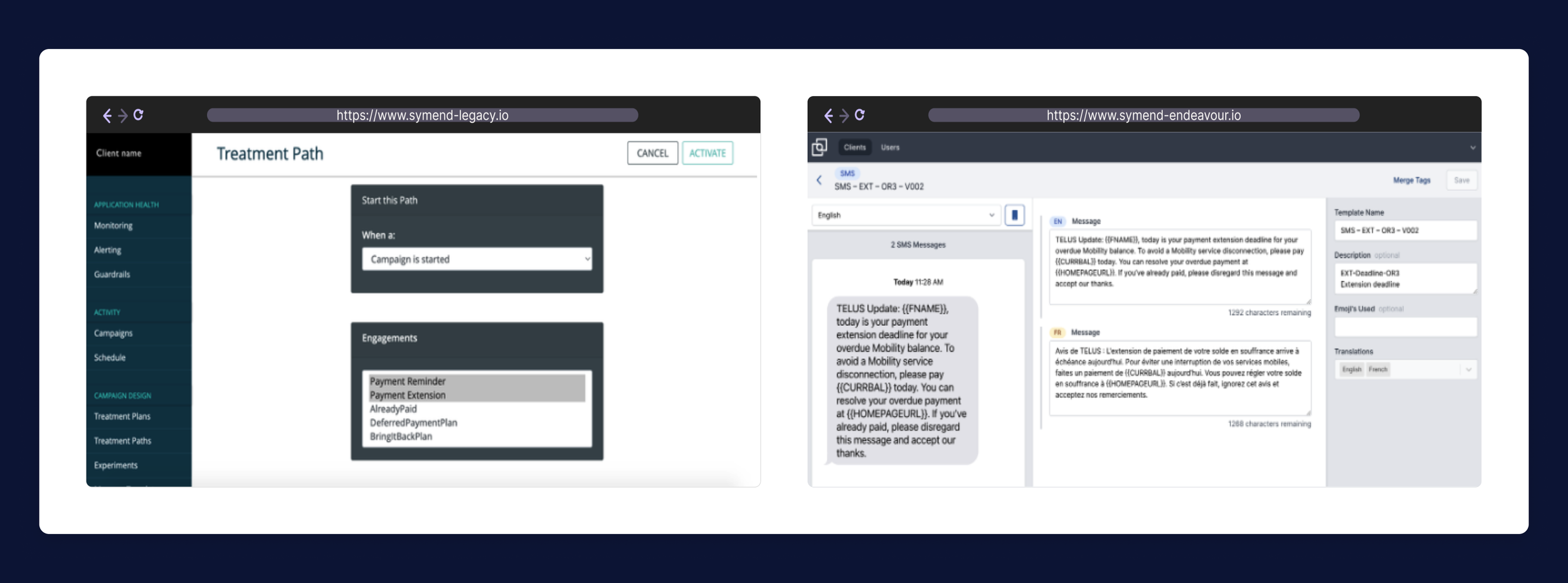Accelerating enterprise outreach through a scalable, self-serve journey builder
Helping teams design and deploy treatment strategies used to reach 100M+ customers, by transforming a fragmented, technical workflow into a unified, visual platform that anyone could use with confidence.
The new Playbooks experience enabled Symend’s clients; banks, telcos, utilities, to design, validate, and launch treatment strategies without relying on engineering or data science teams.
This shift:
Increased user autonomy and reduced dependency on technical specialists
Unified what used to be 3+ separate apps into a single, predictable interface
Reduced configuration errors and build time for new strategies
Established the foundation for future automation, governed components, and scalable design
Impact
Research, conceptual models, UX flows, UI design, prototyping, usability testing, design system creation
Role
Team
A product manager, 3 engineers, data analysts, client-facing strategists, and the compliance/operations team to ensure the system met both business and user needs.
Why this mattered
Symend’s clients rely on treatment strategies to guide how they reach millions of customers during sensitive financial moments. But the legacy approach was scattered across multiple tools, required deep technical knowledge, and left users unsure if their strategies were configured correctly.
The redesigned Playbooks experience:
consolidated multiple apps into one
reduced reliance on technical teams
improved clarity, accuracy, and confidence
empowered users to build and validate strategies independently
Impact: Playbooks became the unified way Symend clients reach and support 100M+ customers across telco, banking, and utilities.
Understanding why strategy creation was so much harder than it needed to be
Symend’s original workflow for designing treatment paths was scattered across multiple legacy tools:
one app for content
one for segmentation logic
one for sending events
and another for visualizing paths
This created:
Fragmentation - users constantly switched tools
Cognitive load - no single view of “what’s happening, where, and why”
High reliance on technical experts - only a few internal SMEs understood the system end-to-end
No visual validation - errors surfaced late, often during engineering handoff
Slow feedback loops - small changes required multi-team coordination
From interviewing strategists, data specialists, client service teams, and leads, one theme emerged clearly:
“I just want to see what’s happening and know it’s right before activating it.”
This became the opportunity: create a unified, visual, self-service Playbook builder.
Legacy authoring tools were fragmented, inconsistent, and required technical support.
Designing for clarity, predictability, and confidence
(Placeholder visual: early flow sketches or conceptual boxes)
From the research, three design pillars emerged:
1. Put important things within reach
Users needed a way to inspect content, rules, timing, and segmentation without leaving the canvas.
2. Reduce friction through guidance
The system should proactively surface issues and guide decision-making.
3. Empower users through exploration
Playbooks needed to feel safe to experiment with—without risking broken logic or mis-configured outreach.
These principles guided the design of:
A consolidated visual canvas
Contextual side panels for editing
Familiar drag-and-drop interactions
Clear, consistent patterns for flow controls
Inline validation and error grouping
The outcome:
A single, predictable place where users could design, test, and validate a strategy from end to end.
Making complexity feel simple (and familiar)
(Placeholder visual: side-by-side comparison of old vs. new card design)
To reduce the learning curve, I drew from familiar mental models:
flowchart logic (draw.io, Miro)
message builders (HubSpot)
personalization patterns (Mailchimp)
side panel editing (modern web apps like Notion / Figma)
This allowed users to:
Click any step to view details instantly
Edit messages, rules, controls, and timing from a single pattern
Move or duplicate steps intuitively
Understand the entire journey at a glance
The interface emphasized clarity:
consistent card hierarchy
intuitive iconography
semantic colors
minimized chrome
predictable placement of actions
This made even complex strategies feel manageable and easy to reason about.
The fragmented, multi-tool ecosystem we were tasked with untangling
Through interviews, shadowing sessions, and platform audits, it became clear that strategy creation was far more difficult than it needed to be. Workflows were fragmented across four different internal tools, requiring strategists to bounce between message builders, segmentation rules, and experimentation controls just to complete a single journey. Nothing existed in one place, and no one had visibility into end-to-end logic.
Strategists described the experience as:
“disconnected and fragile,”
“difficult to trust,”
and “impossible to visualize.”
This reality revealed a compelling opportunity: build a single, unified system that gives users clarity, confidence, and control from start to finish.




